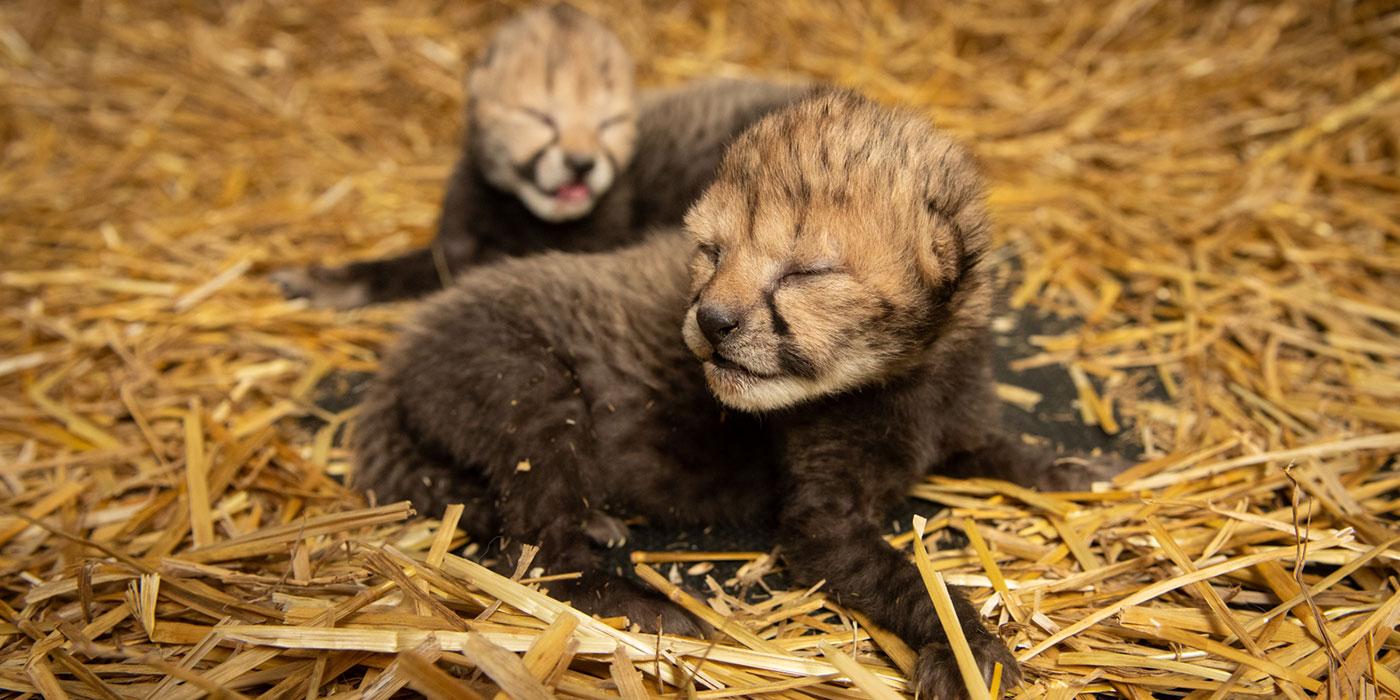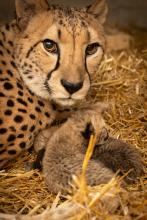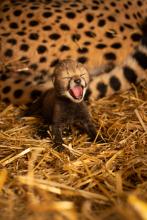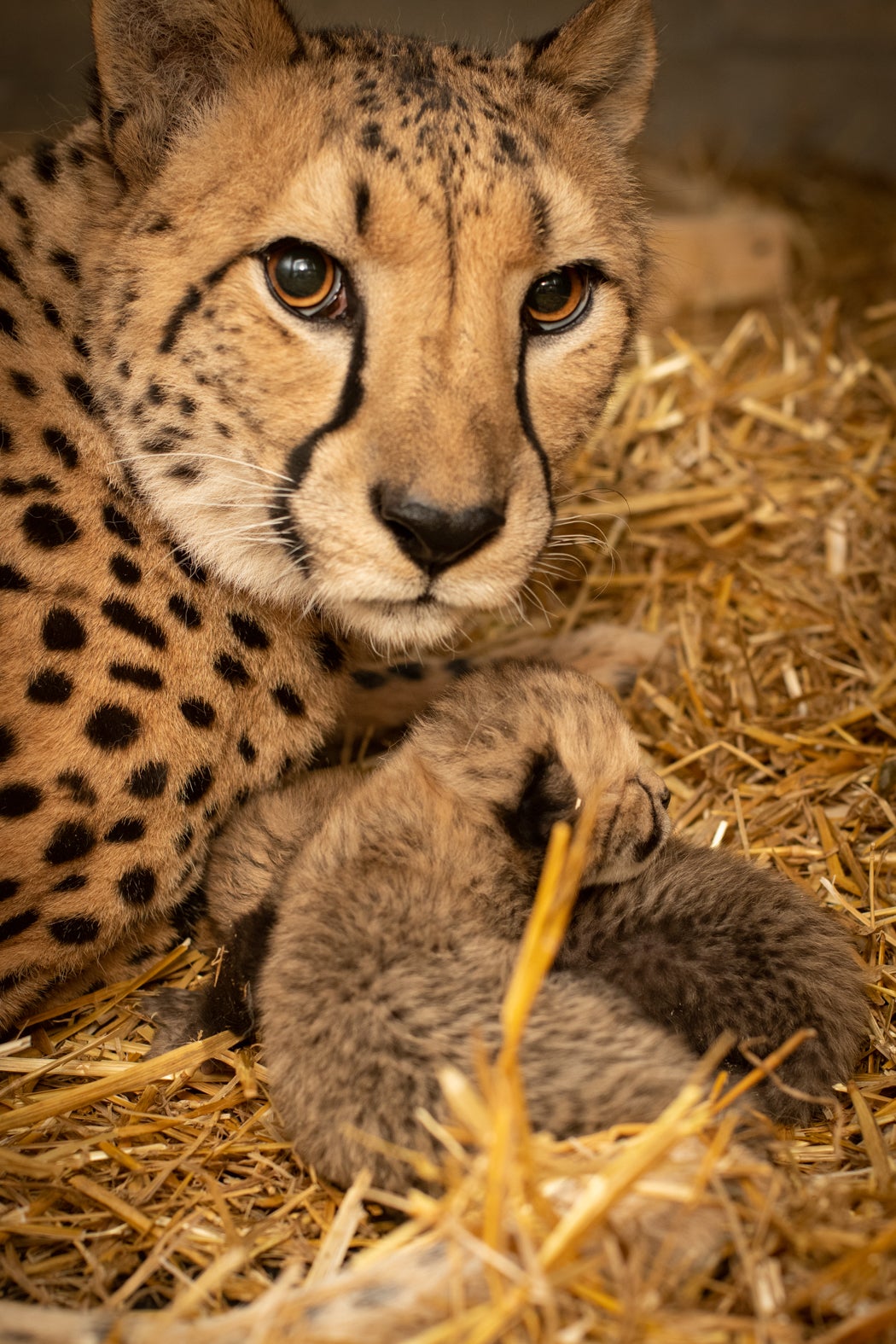First Cheetah Cubs Born as Result of Embryo Transfer

Scientists at the Smithsonian Conservation Biology Institute (SCBI) and the Columbus Zoo have successfully transferred cheetah embryos produced by in vitro fertilization (IVF) to a surrogate cheetah mom for the first time. Two cubs were born Feb. 19 to 3-year-old mom Izzy, though the cubs’ biological mom is 6 1/2-year-old, Kibibi. Cheetahs naturally have low genetic diversity due to a near extinction at the end of the last ice age. However, techniques scientists use to boost genetic diversity and health in other endangered and vulnerable species have not had much success in cheetahs. IVF embryo transfer will help scientists and zoos build the most robust and genetically healthy insurance population of cheetahs in human care possible, and potentially could even help the genetics of wild cheetahs.
For the embryo-transfer procedure, scientists collected semen from a male cheetah living at Fossil Rim Wildlife Center in Texas in February 2019 and froze it. They then harvested eggs from Kibibi at the Columbus Zoo Nov. 19, 2019, and performed in vitro fertilization, fertilizing them in a laboratory with the sperm collected in Texas earlier that year. The fertilized embryos were then transferred to Izzy’s oviduct Nov. 21, 2019. It was only the third time scientists had ever attempted the procedure. Kibibi had never given birth to a cub and is genetically valuable, but she is unlikely to ever reproduce on her own. Her valuable genes were at risk of never being passed on. Izzy, the surrogate, is less genetically valuable and is not currently recommended to breed, but she was hand-raised as a cub and very comfortable with keepers, which made her a good candidate as a surrogate cheetah mom.
“The success of this groundbreaking procedure would not have been possible without the incredible dedication, collaboration, and scientific expertise of the teams at the Smithsonian Conservation Biology Institute, Fossil Rim Wildlife Center and the Columbus Zoo and Aquarium,” said Tom Stalf, President/CEO of the Columbus Zoo and Aquarium. “The additional knowledge we gained throughout this process will serve as an important resource in the future, and we are proud to work with our zoological colleagues on perfecting innovative methods that ultimately can have a direct impact on protecting rare species like cheetahs.”
In December 2019, about a month after the procedure, veterinarians at the Columbus Zoo detected two fetuses on an ultrasound. Cheetah pregnancies typically last between 90 and 96 days. Izzy was monitored closely during her pregnancy and received regular ultrasounds and radiographs. Veterinarians and keepers at Columbus Zoo noticed Izzy began showing signs that she was in labor Wednesday, Feb. 19. The cubs were born later that evening at 9:50 p.m. and 10:20 p.m. They have been observed nursing, and the first day birth weights for the male was 480 grams and the female 350 grams.
SCBI scientists have been studying IVF and embryo transfer in cheetahs for 15 years. In 2005, they began working on collecting and inseminating oocytes, or eggs, in the lab. By 2011, they were able to harvest eggs and fertilize them and routinely produce embryos. Embryo transfer was the next step in their research.
“We have been performing artificial inseminations in cheetahs for decades, and there hasn’t been a cub born in almost 20 years,” said Adrienne Crosier, cheetah biologist at the Smithsonian Conservation Biology Institute, one of the scientists who performed the embryo transfer. “Just the fact that we were successful with embryo transfer after only the third attempt gives me hope for the future of this technique for improving cheetah management, potentially on a global scale. This is a huge scientific breakthrough and, in many ways, is much better because it gives us much more flexibility with limited genetic material. This is an amazing milestone for cheetahs—we can extend a cheetah’s biological clock.”
Approximately one-third of the cheetah population living in zoos is removed from the breeding matrix due to age, health or behavior, and cheetahs’ ability to reproduce after 8 years of age declines significantly. The Association of Zoos and Aquariums’ Cheetah Species Survival Plan (SSP) has been working to increase the number of cubs born each year and maximize the effective breeding population, or the number of individuals contributing genetically to offspring.
“For me, the birth of these IVF cubs is a significant breakthrough for cheetah reproduction, but the implications are enormous,” said Pierre Comizzoli, a reproductive biologist at the Smithsonian Conservation Biology Institute and one of the scientists who performed the embryo transfer. “We continue to improve our understanding of fertility and develop new tools for other species. This is how we make rapid progress with rare and endangered species. One species’ breakthrough opens the door for another.”
Nearly all cheetahs recommended to breed by the SSP live at large off-exhibit facilities like SCBI, Fossil Rim Wildlife Center and The Wilds, which can care for more cats and collectively manage tens of thousands of acres, which has increased the number of cubs born each year. Embryo transfer will help ensure that more cheetahs breed contributing to the genetic diversity of the population and its sustainability. Male cheetahs can father cubs with the females who are their best genetic matches without having to move to the same zoos or facilities as the females. Scientists can collect sperm samples from males, freeze them and then use the sperm for embryo transfer at any point in the future.
Timeline:
- Nov. 14 and 18: The female cheetahs were given hormone injections to develop mature follicles.
- Nov. 19: Eggs (oocytes) were taken from Izzy and Kibibi. Neither had reproduced previously.
- Nov. 19: Semen from male cheetah thawed and eggs fertilized.
- Nov. 21: Team implanted nine embryos in Isabelle (Izzy) and six in second cheetah, Ophelia. A typical cheetah gestation is 93 days.
- Dec. 23: Izzy was confirmed pregnant via ultrasound, which appeared to show two cubs. The ultrasound confirmed that Ophelia was not pregnant.
- Feb. 16: Izzy’s care providers begin an around-the-clock video birth watch
- Feb. 19: Cubs born
Cheetahs are listed as vulnerable by the International Union for Conservation of Nature. During the past 50 years, cheetahs have become extinct in at least 13 countries in Africa, and there are about 7,500 cheetahs remaining in the wild. Habitat destruction, conflict with humans and hunting have caused their numbers to decline.
The Smithsonian Conservation Biology Institute plays a leading role in the Smithsonian’s global efforts to save wildlife species from extinction and train future generations of conservationists. SCBI spearheads research programs at its headquarters in Front Royal, Virginia, the Smithsonian’s National Zoo in Washington, D.C., and at field research stations and training sites worldwide. SCBI scientists tackle some of today’s most complex conservation challenges by applying and sharing what they learn about animal behavior and reproduction, ecology, genetics, migration and conservation sustainability.
All photos courtesy of Grahm S. Jones, Columbus Zoo and Aquarium.
Related Species:
Image Gallery










